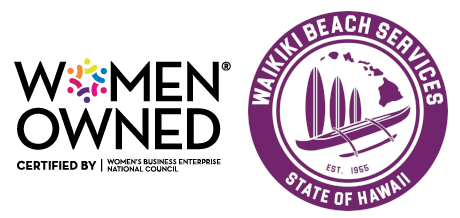Surfboard 101: Get to Know Your Board Before You Hit the Waves
A beginner-friendly guide to the parts of a surfboard and how each helps you confidently ride waves with the Waikīkī Beach Services beachboys.
By Hero Jones
Before you paddle out for your first lesson, it helps to get familiar with the gear under your feet. Understanding the anatomy of a surfboard can make learning to surf easier, safer, and way more fun. Here’s a quick breakdown of the key parts of a surfboard and what each one does:
Nose: The front tip of the board. A pointed nose helps with speed and performance, while a rounded nose adds stability – perfect for beginners.
Deck: This is the top surface of the board, where you’ll be standing. Soft-top boards have a foam surface that’s easier on your feet and knees – and more forgiving if you wipe out!
Rails: The rails are the edges of your board. Softer, rounded rails are more stable and ideal for beginners. As you get more advanced, sharper rails can help with carving and sharper turns.
Stringer: The stringer is the strip running down the center of a surfboard, adding strength, structure, and flex control. It helps your board maintain its shape and gives you better riding stability.
Tail: The back of the board, or tail, affects how your board turns and handles waves. Wider tails give more stability, while narrower tails are better for sharper turns. Most beginner boards have a wider tail to help with balance.
Fins: Located underneath the tail, fins help control direction and add stability. Think of them like the rudder on a boat. Most beginner boards have a simple three-fin setup (called a thruster) to keep you steady.
Leash: A cord that attaches your ankle to the board – so you don’t lose it!
Rocker: The rocker is the curve from nose to tail. A board with more rocker (more curve) is better for steeper waves, while flatter boards are easier to paddle and more stable – again, perfect for learning.
At Waikīkī Beach Services, we use wide, stable longboards ideal for learning and catching mellow waves.
Why It Matters
Getting familiar with the parts of your surfboard helps you listen to your surf instructor, understand what your board is doing under your feet, and feel more confident in the water. Plus, it makes you sound like a seasoned surfer in no time.
Ready to Ride?
Now that you know your nose from your tail, you’re one step closer to catching your first wave! Visit Waikīkī Beach Services to book your lesson today or find us at the beach desk at the Royal Hawaiian Hotel, or the Sheraton Waikīkī Beach and pool. Waikīkī Beach Services has been voted best surf school 5 years in a row by Hawaiʻi Magazine!


